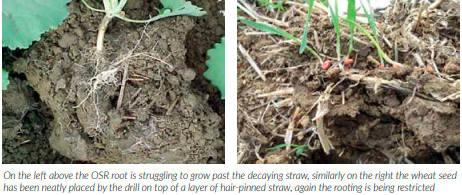By James Warne of Soil First Farming
Drilling is the only operation you have to really influence the crop you harvest later, if the establishment is poor you are
constantly playing a game of catch-up. Get it right and suddenly the husbandry of the crop becomes ever so much easier.
I appreciate that sounds obvious and simplistic, but so often we get it wrong and making an alternative decision would have made the difference for success. While this is also true for cultivation systems, the act of cultivating soil takes a lot of the risk out of crop establishment, in my opinion.

The autumn of 2018 was very dry, preceded by a very dry summer for most of the UK. Consequently, soil biological activity had all but ceased and became dormant. The biological dormancy delayed the onset of decay and digestion of crop residues. Consequently, at drilling there was still considerable chaff and straw residue on the surface. Now while this kind autumn and winter allowed the majority of crops to establish easily, by the time spring arrived things were looking a little different on some crops. Patchyness started to appear with an apparent lack of crop vigour. Once there was sufficient moisture the soil biology awoke and began the process of decay on the chaff and straw, enabled by the warmer winter soils we experienced.
The patchiness and reduced vigour is, we believe, due to the release of toxins as the straw degrades. Many scientific studies have shown that decaying cereal straw releases a variety of phytotoxic compounds, such as acetic, propionic, butyric and phenolic acids. Research also shows that the decaying straw may also increase the effect of Pythium rootrot upon the establishing crop. The photo on the following page displays just how effective decaying straw can be on restricting the root growth. While some choose to ignore or disbelieve this actually is a problem, the scientific research above, coupled with the symptoms we see in the field encourages us to believe that there is clearly an affect, most commonly known as allelopathy.

Here at Soil First Farming we believe this is a bigger problem than most would believe. It is responsible for more disappointing crop yields than it is given credit for. Why? Well it’s much easier to attribute disappointing yield to lack of sunshine or rainfall or poor disease control etc. than to something that happened ten months ago and you could have directly contributed to. The usual early symptoms (in extreme circumstances) are stunted growth, lack of vigour and discoloured leaves. But by late spring seemingly unaffected crops may not have tillered, or drop tillers the root system cannot support, and ultimately the crop may produce smaller ears.
The type of drill used can play a big part in this effect. Contrary to popular belief disc drills do not cut through chopped straw perfectly at all times. Discs tend to push the straw and chaff into the slot which results in hair-pinning and thus the seed is paced upon a layer of straw and chaff. In extreme circumstance the disc can actually ride -out of the ground and place the seed on the soil surface.
This hair-pinning can exacerbate the problem described above to the extent that the roots of the establishing crop can be severely pruned and restricted in their growth as shown in the laboratory photo above. This can also be seen in the field. Below are two examples of hair-pinned crops that we see on a regular basis.
What are the solutions?
Drill: Use the appropriate type of drill when drilling into dry residue situations, a tine drill should be the default choice unless you believe that the disc will make a better option, but this is unlikely.
Rotation: One of the tenets of Conservation Agriculture is diversity. Maybe trying to establish a second cereal is not the best choice?
Nutrition: The correct starter fertiliser choice coupled with correct timing and quantity can help to alleviate the effects.
Finally, for UK conditions a tine drill should be the default drill of choice, only swapping for a disc drill in situations where a tine drill won’t work e.g. drilling into large biomass cover crops, or when there is very little dry lignified residue. Both of these situations also require the soil moisture conditions to be perfect.
